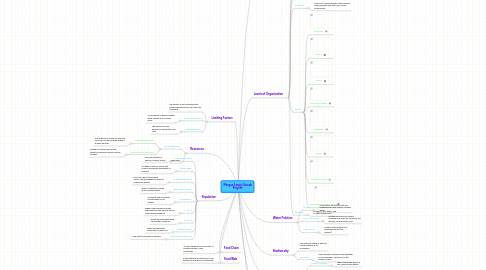
1. Food Chain
1.1. A Chain Showing One Direction of Energy Transfer in and Ecosystem
2. Food Web
2.1. A web showing all directions of the transfer of energy in an ecosystem
3. Limiting Factors
3.1. The Factors in an Ecosystem that Control the Amount of Life That Can Live There
3.2. Climax Community
3.2.1. A Community in Balance where Every species is in a Stable Cycle
3.3. Carrying Capacity
3.3.1. The Amount of One Species an Ecosystem Can Hold
4. Population
4.1. Populaton Growth
4.1.1. The Rate at which a Specific Species Grows
4.2. Black Plauge
4.2.1. A Plauge in Mid Evil Times that Majorly Dented the Population of Humans
4.3. Industrial Revolution
4.3.1. From the 1800's to the early 1900's-had the biggest increase in population growth
4.4. Exponentail Growth
4.4.1. When a Population Grows at an Increasing Rate
4.5. Sustainability
4.5.1. A Species able to Sustain the Population in its Habitat
4.6. J-Curve
4.6.1. When a the Population Grows Exponentailly until the Line on the Chart goes Straight Up
4.7. S-Curve
4.7.1. When the Population Goes up and they Levels off.
4.8. Logistic Growth
4.8.1. When the Population Grows until it Levels off
4.9. Populatoin Growth Rate
4.9.1. How Fast a Population Increases
5. Resources
5.1. Natural Resources
5.1.1. Renewable Resources
5.1.1.1. Any material or energy source that cycles or can be replaced within a human life span
5.1.2. Non-Renewable Resources
5.1.2.1. Material or energy source that cannot be replaced during a human life span
5.2. New node
6. Levels of Organization
6.1. Organism
6.1.1. Any Living Thing
6.2. Population
6.2.1. Groups of Individuals of the Same Species Found in a Given Area or Located in the Same Area at a Given Time
6.3. Community
6.3.1. Populations of Living Organisms Interacting with Eachother in an Ecosystem
6.4. Ecosystem
6.4.1. Groups of Living Organisms that Interact with Eachother and their Non-Living Enviornment
6.5. Biome
6.5.1. Rainforest
6.5.2. Desert
6.5.3. Tundra
6.5.4. Grassland/Savanah
6.5.5. Freshwater
6.5.6. Marine
6.5.7. Coniferous Forest
6.5.8. Temperate Deciduous Forset
6.6. Biosphere
6.6.1. A Layer of Soil, Water, and Air that Sustains Life
7. Trophic Pyramid
7.1. Producer
7.1.1. Organisms that Produce their own Energy from the Sun
7.2. Trophic Levels
7.2.1. Trophic= Energy
7.3. Consumers
7.3.1. Organisms that eath other Organisms
7.3.1.1. Primary Consumer
7.3.1.1.1. Eats the Producer
7.3.1.2. Secondary Consumer
7.3.1.2.1. Eats the Primary Consumer
7.3.1.3. Tertiary Consumer
7.3.1.3.1. Eats the Secondary Consumer
8. Aboitic Factors
8.1. All of the nonliving things impacting an ecosystem
9. Biotic Factors
9.1. All of the living things impacting an ecosystem
10. Biodiversity
10.1. The Different Types of Species Living Together in an Ecosystem
10.2. Hot Spots
10.2.1. Many Different Species Living Together in an Ecosystem; Covers 2% of the Earths Surface
11. Ecological Succession
11.1. Primary Succesion
11.1.1. When Life Grows Where it has Never Grown Before
11.2. Secondary Succesion
11.2.1. When Life Grows Where it Once was But was Destroyed
11.3. Pioneer Species
11.3.1. The First Species to Grow in a new Ecosystem
12. Water Polution
12.1. Aquifer
12.1.1. A Geological Formation that is an Underground Layer of Rock Holding Water
12.2. Non Point Source
12.2.1. Polution coming from several untracable sources (ex: Ferilizers, Pet Waster, Car emmisions, ect.)
12.3. Point Source
12.3.1. Polution coming from one idenifiable source (Ex: Factory)
